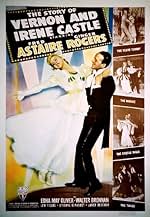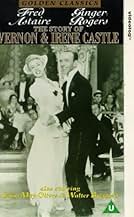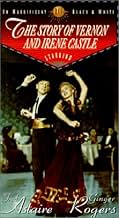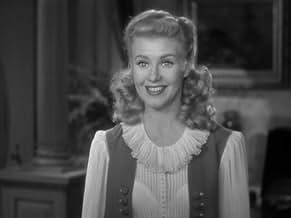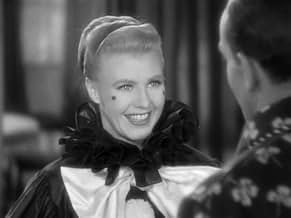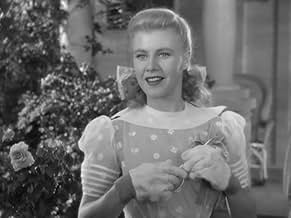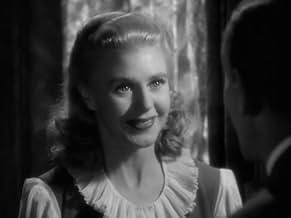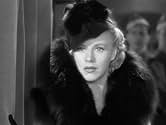A História de Irene e Vernon Castle
Título original: The Story of Vernon and Irene Castle
AVALIAÇÃO DA IMDb
6,9/10
2,9 mil
SUA AVALIAÇÃO
Adicionar um enredo no seu idiomaThe story of the dancing team who taught the world to two-step.The story of the dancing team who taught the world to two-step.The story of the dancing team who taught the world to two-step.
- Direção
- Roteiristas
- Artistas
- Prêmios
- 4 vitórias e 1 indicação no total
Buzz Barton
- Undetermined Secondary Role
- (não creditado)
Max Barwyn
- Waiter - Cafe de Paris
- (não creditado)
Avaliações em destaque
This was the last of the Astaire and Rogers films at RKO (they would reunite at MGM for "The Barkeleys of Broadway" [1949]), and represents the studio attempting to find a new way to make the duo popular. It's hard to believe, since the pair have become legends in Hollywood musical history, but by the end of the 1930s audience interest in Astaire and Rogers seemed to be ebbing. Consequently, this film feels *very* different than the rest of their films.
This is not a story of boy meets girl/boy dances with girl/boy loses girl/boy chases and chases girl/boy gets girl and dances with her again. There aren't a ton of the whimsical oddball comic supporting players. And--steady yourself--there are very few full-out major musical numbers. There is no stunning score of songs by Irving Berlin or the Gershwins.
This is because this is a musical biography about the Astaire and Rogers of the previous generation. Hence, the duo are asked not to dance in the manner that made them popular but in the manner that made *the Castles* popular, and to music that *that* couple danced to. Often, when the two dance, we are interrupted by various plot points (ie., cutting to other characters talking instead of keeping the camera on the dancers). One of the few moments where we are able to enjoy them completely is a montage sequence showing the Castles becoming the toast of the nation (with Astaire and Rogers literally dancing across a giant map of the U.S.)
The other major musical number is a solo: Ginger Rogers singing "The Yama Yama Man." Astaire was about to end his contract at RKO, but Rogers still was under contract--so the studio is plainly more interested in trying to build up Rogers for a solo career, and the film indicates this (Rogers' solo, the emphasis on her clothes and hair, etc.) Meanwhile, the film also indicates a growing awareness of the coming war, by dealing with Vernon Castle's enlistment during World War I--one of the first times Astaire had donned a uniform for the cameras (something he would do a *lot* in musicals for the next 5 years).
All in all, it's not what one usually expects from an Astaire and Rogers film, and thus suffers in comparison to "Top Hat" or "Shall We Dance," but still retains a charm and personality nonetheless.
This is not a story of boy meets girl/boy dances with girl/boy loses girl/boy chases and chases girl/boy gets girl and dances with her again. There aren't a ton of the whimsical oddball comic supporting players. And--steady yourself--there are very few full-out major musical numbers. There is no stunning score of songs by Irving Berlin or the Gershwins.
This is because this is a musical biography about the Astaire and Rogers of the previous generation. Hence, the duo are asked not to dance in the manner that made them popular but in the manner that made *the Castles* popular, and to music that *that* couple danced to. Often, when the two dance, we are interrupted by various plot points (ie., cutting to other characters talking instead of keeping the camera on the dancers). One of the few moments where we are able to enjoy them completely is a montage sequence showing the Castles becoming the toast of the nation (with Astaire and Rogers literally dancing across a giant map of the U.S.)
The other major musical number is a solo: Ginger Rogers singing "The Yama Yama Man." Astaire was about to end his contract at RKO, but Rogers still was under contract--so the studio is plainly more interested in trying to build up Rogers for a solo career, and the film indicates this (Rogers' solo, the emphasis on her clothes and hair, etc.) Meanwhile, the film also indicates a growing awareness of the coming war, by dealing with Vernon Castle's enlistment during World War I--one of the first times Astaire had donned a uniform for the cameras (something he would do a *lot* in musicals for the next 5 years).
All in all, it's not what one usually expects from an Astaire and Rogers film, and thus suffers in comparison to "Top Hat" or "Shall We Dance," but still retains a charm and personality nonetheless.
Here's one of those rare films that I like where there are no villains, just a nice, old-fashioned story with good people.
Of all the Fred Astaire-Ginger Rogers films, I would guess this gets the least amount of publicity and if that's true, it's a shame.
There are plenty of dance scenes in here. I prefer the tap dancing to ballroom, but that's just my personal tastes. The famous dancing duo are great with any style. I like Walter Brennan, so it's nice to see him in this film and it also was nice to see Edna May Oliver play a nice character, for a change.
The only complaint was the ending was so predictable. You see it coming a mile away. How true this story is, I can't say, but overall it's one of my favorite Astaire-Rogers movies. I am sorry it gets so little attention.
Of all the Fred Astaire-Ginger Rogers films, I would guess this gets the least amount of publicity and if that's true, it's a shame.
There are plenty of dance scenes in here. I prefer the tap dancing to ballroom, but that's just my personal tastes. The famous dancing duo are great with any style. I like Walter Brennan, so it's nice to see him in this film and it also was nice to see Edna May Oliver play a nice character, for a change.
The only complaint was the ending was so predictable. You see it coming a mile away. How true this story is, I can't say, but overall it's one of my favorite Astaire-Rogers movies. I am sorry it gets so little attention.
There is one hilarious goof in this delightful film. When Irene and Vernon are having dinner in the Parisian restaurant in which they are to make their debut Irene is wearing her wedding dress as they are too broke to afford to buy her a new evening dress, She is also wearing a little lacy winged hat of the type worn in the national costume of Holland.
In England there were gales of laughter when Irene says "I feel just like a bride again in my wedding dress and my little Dutch cap." In the UK a Dutch cap is a female contraceptive device which I believe is called a "diaphragm" in USA.
In England there were gales of laughter when Irene says "I feel just like a bride again in my wedding dress and my little Dutch cap." In the UK a Dutch cap is a female contraceptive device which I believe is called a "diaphragm" in USA.
"The Story of Vernon and Irene Castle" was the last of the major Fred Astaire - Ginger Rogers musicals of the 1930s. And it was different in many ways from the others, namely that the story was more important than the songs and dances.
Really, is "Top Hat" with its emphasis on production numbers linked by a thin plot of mistaken identity really a lot different than today's action movies with endless car chases and pyrotechnic special effects linked by a very thin story about a hit man or the earth getting hit by a comet? Sorry about that analogy, I'll take the great musicals over the "actions" any day! "Yo" is not great dialog.
My parents tell me that at the time, this film was panned by the critics and did not make it as big at the box office. Could it be that everyone wanted another "Top Hat" or Swing Time?" I enjoyed those lovely musicals with their big production numbers. Could it be the emphasis on Vernon's patriotic service with the RAF in World War I might have offended many people's "isolationism" in 1939 about the growing World War II?
Fred and Ginger wanted to do a movie with more substance, and they pulled it off in grand style. The songs and dances were nice, with only one very brief "production number." But they did a great job of showing how two young entertainers met, fell in love, became famous, and made a sacrifice in the war. In 1911, young Irene Castle "discovers" Vernon, a second-rate vaudeville comic when she sees him dancing at an evening outing. She shows Vernon her not ready for prime time dance number "The Yama Yama Men." The two fall in love and marry, and with a lot of self-taught dance technique, suddenly hit the big time in France by dancing their famous "Castle Walk." The Castles' fame grew and grew and they toured Europe and America, and made a lot of money through merchandising things like Irene Castle hats. Long before Michael Jordan's basketball shoes. In fact, you will see entries for both Vernon and Irene here in the Movie Database. Irene went on to star in a few silent films, but never made a "talkie." You'll be glad to know that Irene served as an advisor for the Rogers -Astaire film, enhancing its accuracy.
As always, they had some great character actors. I never knew Walter Brennan was ever that young. Fred and Ginger really showed a depth to their acting. From there, of course, Ginger moved into dramatic movies, including her Oscar-winning "Kitty Foyle." I think Fred's later movies matured too.
In short, I think you will like this movie, but don't expect to see a clone of "Swing Time."
Really, is "Top Hat" with its emphasis on production numbers linked by a thin plot of mistaken identity really a lot different than today's action movies with endless car chases and pyrotechnic special effects linked by a very thin story about a hit man or the earth getting hit by a comet? Sorry about that analogy, I'll take the great musicals over the "actions" any day! "Yo" is not great dialog.
My parents tell me that at the time, this film was panned by the critics and did not make it as big at the box office. Could it be that everyone wanted another "Top Hat" or Swing Time?" I enjoyed those lovely musicals with their big production numbers. Could it be the emphasis on Vernon's patriotic service with the RAF in World War I might have offended many people's "isolationism" in 1939 about the growing World War II?
Fred and Ginger wanted to do a movie with more substance, and they pulled it off in grand style. The songs and dances were nice, with only one very brief "production number." But they did a great job of showing how two young entertainers met, fell in love, became famous, and made a sacrifice in the war. In 1911, young Irene Castle "discovers" Vernon, a second-rate vaudeville comic when she sees him dancing at an evening outing. She shows Vernon her not ready for prime time dance number "The Yama Yama Men." The two fall in love and marry, and with a lot of self-taught dance technique, suddenly hit the big time in France by dancing their famous "Castle Walk." The Castles' fame grew and grew and they toured Europe and America, and made a lot of money through merchandising things like Irene Castle hats. Long before Michael Jordan's basketball shoes. In fact, you will see entries for both Vernon and Irene here in the Movie Database. Irene went on to star in a few silent films, but never made a "talkie." You'll be glad to know that Irene served as an advisor for the Rogers -Astaire film, enhancing its accuracy.
As always, they had some great character actors. I never knew Walter Brennan was ever that young. Fred and Ginger really showed a depth to their acting. From there, of course, Ginger moved into dramatic movies, including her Oscar-winning "Kitty Foyle." I think Fred's later movies matured too.
In short, I think you will like this movie, but don't expect to see a clone of "Swing Time."
How strange to contemplate the enormous popularity of Vernon and Irene Castle before World War I and to realize that, without this film, no one would know who they are today. I hope the same is never true of Fred Astaire and Ginger Rogers' teaming. Because of their presence on film in ten movies, it shouldn't.
Based on two Irene Castle books, this movie has more plot and more drama than the other Fred and Ginger pairings, and if you can accept that it isn't "Flying Down to Rio," "Top Hat," or "Swing Time," you'll enjoy it. Ginger Rogers does a great job as Irene, in the more dramatic of the two roles, proving again what a wonderful actress she was. The dancing was, of course, great. Ginger's gowns were actually copies of Irene's trendsetting gowns. Irene's hairstyle was well-known as well, and she wanted Ginger to dye her hair dark to match her own. But Rogers refused.
Vernon and Irene, during their short pairing, introduced many dances to the public, including the "Castle Walk" and the fox trot.
The movie's ending is a sad one, but I can't agree with another poster than the final visual was trite. I kind of liked it.
Based on two Irene Castle books, this movie has more plot and more drama than the other Fred and Ginger pairings, and if you can accept that it isn't "Flying Down to Rio," "Top Hat," or "Swing Time," you'll enjoy it. Ginger Rogers does a great job as Irene, in the more dramatic of the two roles, proving again what a wonderful actress she was. The dancing was, of course, great. Ginger's gowns were actually copies of Irene's trendsetting gowns. Irene's hairstyle was well-known as well, and she wanted Ginger to dye her hair dark to match her own. But Rogers refused.
Vernon and Irene, during their short pairing, introduced many dances to the public, including the "Castle Walk" and the fox trot.
The movie's ending is a sad one, but I can't agree with another poster than the final visual was trite. I kind of liked it.
Você sabia?
- CuriosidadesIrene Castle served as a technical advisor on the film. According to Ginger Rogers, Castle disliked every costume she wore and deemed them anachronistic. Due to censorship restrictions, Rogers' costumes evoked late 1930s fashions rather than the more daring styles of Castle's 1910s era. After Rogers refused to bob her hair to portray the hairstyle that Irene had popularized, Castle became more displeased. The studio silenced Castle's protests with an additional payment of $5,000.
- Erros de gravaçãoThe film erroneously depicts the Castles touring with white orchestras. In actuality, Vernon and Irene Castle always toured with a black orchestra; specifically, James Reese Europe's Society Orchestra.
- Citações
Irene Castle: I thought you could be a first dancer, a very beautiful first dancer because you are a beautiful dancer but you're so smug and conceited that you can't see any further than your funny nose!
- ConexõesFeatured in Fred Astaire: Puttin' on His Top Hat (1980)
- Trilhas sonorasOnly When You're in My Arms
(1939)
by Con Conrad - Herman Ruby Bert Kalmar
Sung by Fred Astaire (uncredited)
End dance: Fred Astaire (uncredited) and Ginger Rogers (uncredited)
Principais escolhas
Faça login para avaliar e ver a lista de recomendações personalizadas
- How long is The Story of Vernon and Irene Castle?Fornecido pela Alexa
Detalhes
- Data de lançamento
- País de origem
- Idioma
- Também conhecido como
- A Vida de Vernon e Irene Castle
- Locações de filme
- Empresa de produção
- Consulte mais créditos da empresa na IMDbPro
Bilheteria
- Orçamento
- US$ 1.196.000 (estimativa)
- Tempo de duração1 hora 33 minutos
- Cor
- Proporção
- 1.37 : 1
Contribua para esta página
Sugerir uma alteração ou adicionar conteúdo ausente

Principal brecha
By what name was A História de Irene e Vernon Castle (1939) officially released in Canada in English?
Responda
